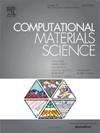A surrogate multiscale model for the design of high entropy alloys
IF 3.1
3区 材料科学
Q2 MATERIALS SCIENCE, MULTIDISCIPLINARY
引用次数: 0
Abstract
We propose a multi-scale physically-based model, for estimating the mechanical properties of a multicomponent alloy by statistically bridging the atomistic (), dislocation () and macro () length scales. We propose a temperature and strain-rate dependent dislocation theory model in which the velocity of dislocations is controlled by the average distance between barriers for dislocation glide i.e. the mean free path. The mean free path depends on the estimated distance between lattice distortions employing an atomistic model, and on the evolving immobile dislocation density as calculated by a modified Kocks–Mecking model, in which the mobility of dislocations is determined by the material stacking fault energy. The calculated flow curves and dislocation densities show good agreement with experimental data. The model relies on physically-based equations and parameters coherent with the literature, without empirical parameters, thus holding potential to speed up the pre-design phase of High Entropy Alloys for aerospace and nuclear components.

求助全文
约1分钟内获得全文
求助全文
来源期刊

Computational Materials Science
工程技术-材料科学:综合
CiteScore
6.50
自引率
6.10%
发文量
665
审稿时长
26 days
期刊介绍:
The goal of Computational Materials Science is to report on results that provide new or unique insights into, or significantly expand our understanding of, the properties of materials or phenomena associated with their design, synthesis, processing, characterization, and utilization. To be relevant to the journal, the results should be applied or applicable to specific material systems that are discussed within the submission.
 求助内容:
求助内容: 应助结果提醒方式:
应助结果提醒方式:


